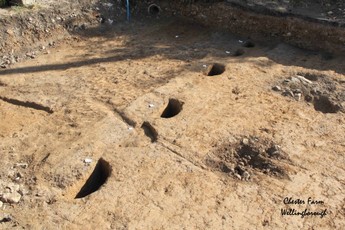Morinsbury Manor
Mowsbury Hillfort
In search of Ralph Morin
Manorialism came about during the Roman era. It occurred when the landowners needed to control both the land they owned and the people who worked it. This was a necessity in the midst of the civil disorders, weak government and barbaric invasions that engulfed Europe in the 5th and 6th centuries. During this time the small farmers and peasants who worked the land exchanged their freedom and guaranteed their services in return for the protection of the landowners who were able to defend them.
This medieval site has been identified with the Manor of Morinsbury, mentioned in various documents prior to 1465. The name may have been retained as `Morsebury'- the title of a field owned by the Goswick family in the 16th century which included the area of earthworks and presumably devolved to the present name of Mowsbury.

Rural manor houses in the early medieval period would have been relatively small. Their size would have been restricted probably to about two metres in width depending on the lengths and cost of the cross support timbers. (Photograph of medieval post holes at Chester Farm, Wellingborough). The main vertical timbers would have been dug into the ground occasionally placed on stone supports. The external structure would have been plastered with wattle and daub and and the roof thatched.
The majority of moated sites served as prestigious aristocratic or seigneurial residences, with the moat acting as a status symbol rather than a means of military defence. Moated sites reached a peak of popularity between the mid 13th and 14th centuries.
Ralph de Morin the elder filled various administrative posts under Henry II, Richard and John. He was sheriff of Northamptonshire in 1184, an officer of the Exchequer in 1189, and an itinerant Justice in 1200. He also attended John in his expedition to Ireland and acquired property in Dublin and served as Sheriff of Devon from 1201.
As the sheriff of Northamptonshire he would have had significant holdings there and it is recorded that he also owned land in Ravensden between 1195 and 1207 and this included Morinsbury Manor. The name Mowsbury is a corrupted name for Morinsbury, Morin and "Bury" being an old English word for castle or fortification. The name may have been retained as "Morsebury" a 16th century field name, which included the area of earthworks.
Ralph De Morin the elder was born in Harrold, Bedfordshire in 1189 and married Albreda De Briouse,they had a child who was named after his father and became known as Sir Ralph Morin.Other records show that Ralph Morin the elder had a brother named Thomas and that they both jointly served as Sheriffs of Northamptonshire in 1183.
Ralph with Gilbert Morin occur in 1189-90 in Buckinghamshire and Bedfordshire; as does another Yorkshire tenant of the Archbishop's, William Morin, who possibly may have been Robert's son. Ralph Morin the younger was the father-in-law of John de Pabenham. In 1232 Simon de Blosseville acknowledged the right of Sir Ralph Morin to 4 hides of land in Harrold Bedfordshire. The Morin family had at this time been established in the parish for some years, for as early as 1194 Ralph Morin paid the sheriff 62s. 1d. for a half fee here. Between 1202 and 1235 Ralph Morin was engaged in various suits concerning small portions of land, and in 1235 was acknowledged to hold two knights' fees in Harrold. Sir Ralph Morin, the younger and John his son-in-law obtained a charter of free warren in their demesne lands in 1253 and in 1271–2 they were accused of unjustly distraining Hugh Gobion and Maud his wife, free tenants in Harrold.
The daughter of Sir Ralph Morin, named Niomi or possibly Phillipa married John de Pabenham in 1246 and this continued the family's local land holding tradition. Their descendants through the Pabenhams and Cheneys included three wives of King Henry VIII (Anne Boleyn, Jane Seymour and Catherine Howard), the first Queen Elizabeth and her younger brother, King Edward VI. The common ancestor of these five people was Elizabeth Cheney (Sir Ralph Morin's 5th great grand-daughter). She married Frederick Tilney then John de Saye. Thus within 10 generations the descendants of de Morin family of Harrold had moved from country squires to monarchs of the realm. Family Tree.
The above information was derived from many different sources and as the actual history at this time appears somewhat vague we would welcome any assistance in correcting this brief history of the Morin’s connection with Mowsbury Hillfort.
Acknowledgements and credits
Ralf Morin and Morinsbury Manor are still being researched. Any assistance with further information or to put us right on the heritage of this family would be gratefully appreciated. contact@putnoemowsburyfriends.org.uk

